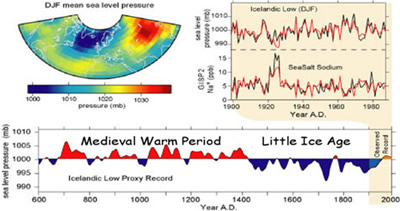Over the North Atlantic
Climate Change Institute and Department of Earth Sciences
Global scale ice core research programs conducted by the Climate Change Institute (CCI) have dramatically expanded our understanding of climate change through findings such as:
- demonstration of the existence of abrupt changes in climate that are characterized by massive shifts in the behavior of atmospheric circulation patterns and sea ice operating over scales and magnitudes highly relevant to humans and ecosystems (eg., Mayewski et al., 1993; 1994; 1996; 1997);
- evidence that natural climate varies on multi-annual to decadal to centennial to millennial scales as a consequence of the interaction of multiple forcing (changes in orbitally induced insolation, changes in solar output, changes in ice-ocean-atmospheric dynamics, changes in greenhouse gas and aerosol content of the atmosphere (eg., Mayewski et al., 1997; );
- demonstration that recent warming is inconsistent with natural climate variability and has, therefore been impacted by human activity (Mayewski and Maasch, 2006); and
- identification of the impact of human activity on the chemistry of the atmosphere notably: greenhouse gases, acids, toxic chemicals, and radionuclides (e.g., Mayewski et al., 1986; 1990; Mayewski and Legrand, 1990).
To understand the past behavior of climate and deconvolute natural from anthropogenic controls on climate change requires records of climate that extend back in time significantly farther back than the short instrumental era records (~100 years in the Northern Hemisphere and ~50 years in the Southern Hemisphere). To have confidence that these records are realistically documenting critical elements of the climate system requires that the ice core records be carefully calibrated to instrumented records. CCI is a leader in the recovery, multi-parameter analysis, calibration, and interpretation of ice core records that allow reconstruction of major atmospheric circulation features (e.g., El Niņo - Southern Oscillation, Icelandic Low, Siberian High, Southeast Asian Low, Aleution Low, Amundsen Sea Low, westerlies in both hemispheres). The December-January-February behavior of the Icelandic Low plays an important role in the climate of Maine and surrounding regions. Instrumentally calibrated ice core reconstructed behavior of the Icelandic Low reveals major changes over the last few hundreds and the beginning of change associated with warming plus decadal scale predictability during the pre-anthropogenic era.


